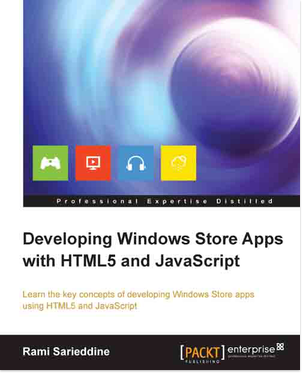Developing Windows Store Apps with HTML5 and JavaScript Review

I was asked by Packt Publishing to do a review of their book, Developing Windows Store Apps with HTML5 and JavaScript. I accepted it because it is such a hot topic and I am always interested in new technologies, specially from the Microsoft world.
First, it is worth noting that I knew absolutely nothing about Windows Store, except that there APIs for accessing it in JavaScript and .NET, which is exactly the profile that the book targets.
The first and second chapters are only about HTML5 and CSS3 and how they are rendered and supported in Windows 8 and Internet Explorer 10. Some functionality makes use of Microsoft extensions to CSS, namely, the part about the layouts, and it doesn’t make any effort to make it cross-browser.
The third chapter talks about JavaScript objects available specifically for Windows 8 – the Windows Library for JS. This provides shortcuts for common DOM tasks and for working with the new controls.
Next, on the fourth chapter, we start learning about building full apps, and for all the other aspects related with it, such as tools and licenses. We go from scratch into a full-fledged application.
Fifth chapter shows us how to display data visually by binding it to the ListView control. Sorting and filtering is also demonstrated.
Chapter six explains how to make the application more responsive, by leveraging multiple views, reacting to the actual screen size and orientation and applying “semantic zoom”.
On the seventh chapter we learn about how to display notifications on the Start screen. Tiles, badges and notifications are all presented and explained.
On chapter eight we learn about the registration process for submitting a new app to the store and how to obtain information about the current user.
Chapter nine is again about the user interface, this time, menus and commands.
Next chapter, ten, is all about packaging and deploying our app to the store. We are offered a tour of the process, which is a complex one, and requires third-party interaction, namely, the certification phase from Microsoft.
Finally, chapter eleven explains how to implement the user interface in XAML, which is an alternative method to using HTML. The two techniques, however, can coexist in the same application, by using different pages.
This being said, it was an interesting read, a nice book for getting into this new thing, although I guess more experienced users will find it limiting. Good for starters, definitely.
All included examples can be implemented with either a free version of Visual Studio - Visual Studio Express 2012 - or a commercial one. Of course, you will also need Windows 8 for the APIs to work, which should be no surprise.